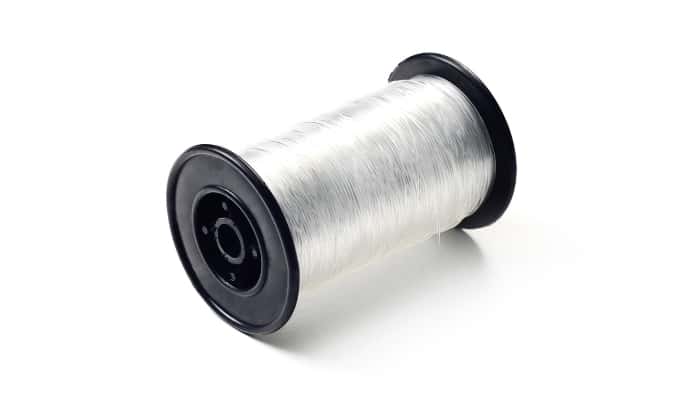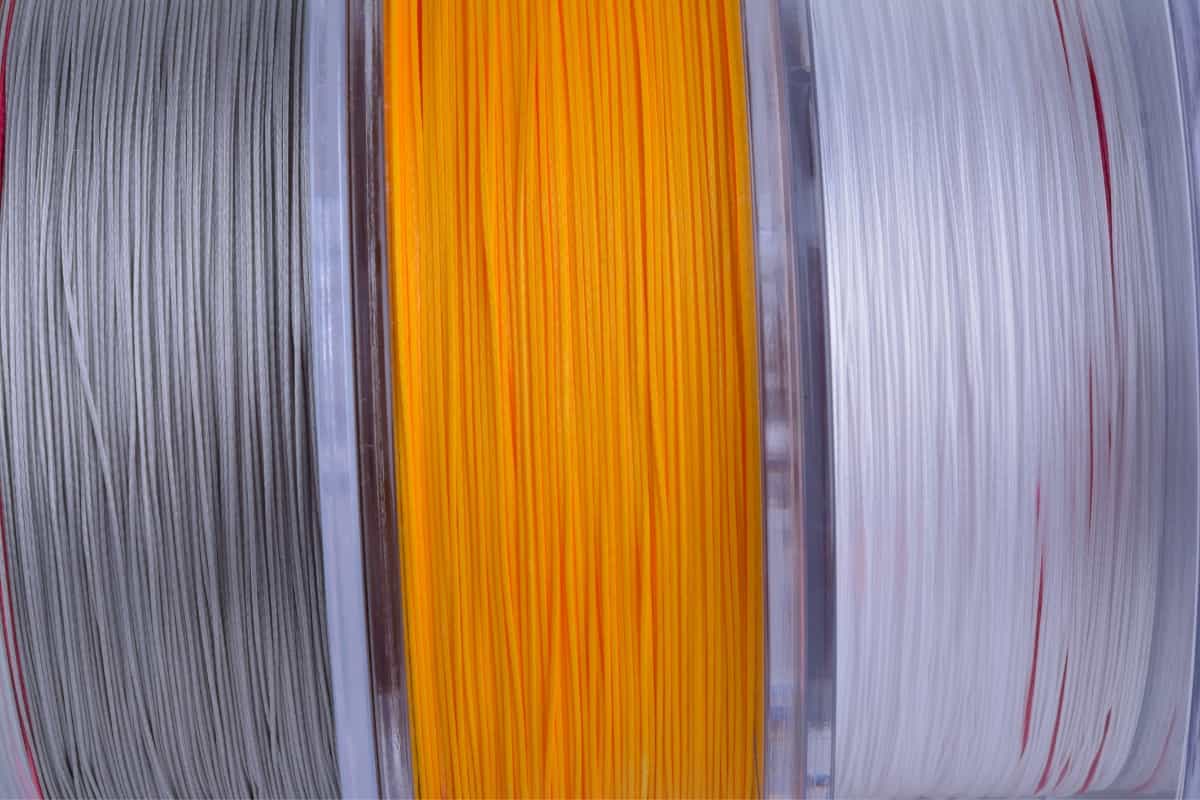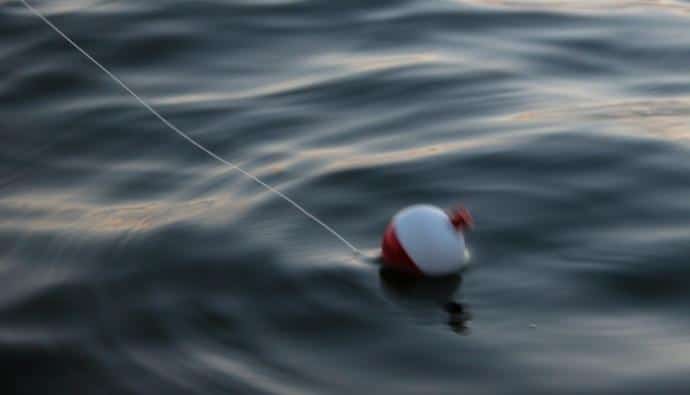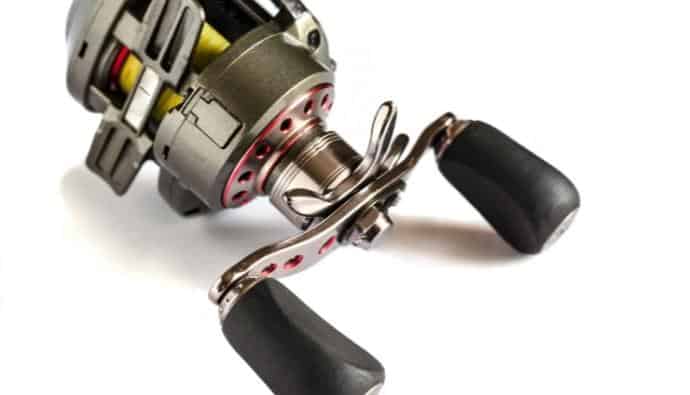Quality fishing line can be the difference between reeling in a trophy catch and losing the battle.
In this article, we’ll delve into the factors that impact their longevity, guiding you on when to retire your old fishing line and replace it with a fresh one.
Moreover, we’ll reveal priceless tips on maintaining and storing your fishing line to extend its life. Ready to hook some fascinating insights? Stay with us, as there’s a thrilling revelation waiting just below the surface!

Types of Fishing Lines and Their Average Lifespan
Here are the most common types of fishing lines – the monofilament line, fluorocarbon line, and braided line:
Monofilament Fishing Line
The monofilament line reigns as a top pick among fishing enthusiasts.
Crafted from a single nylon strand, the versatile monofilament line is easy to handle and adapts effortlessly to a range of fishing conditions. Its budget-friendly nature adds to its allure, making it a staple in many tackle boxes. But how long does it last?
Typically, monofilament line endures for 2 to 3 years, with factors such as sunlight exposure, water temperature, and fishing frequency affecting its lifespan.
Fluorocarbon Fishing Line
Enter the fluorocarbon fishing line – a formidable alternative.
Its dense, robust material composition renders it practically invisible underwater, making it a popular choice for those seeking sensitivity, abrasion resistance, and minimal stretch. But how long can it hold up?
Fluorocarbon fishing lines impressively boast a lifespan of 7 to 10 years. However, factors such as storage conditions, sunlight exposure, and usage patterns can impact their longevity.
Braided Fishing Line
Braided fishing line is a favorite among many anglers.
The braided line is made from multiple strands of synthetic fibers woven together, creating an incredibly strong and thin fishing line. A braided line is known for its high strength-to-diameter ratio, minimal stretch, and excellent casting distance.
When it comes to lifespan, braided fishing line outshines the others. It can last up to 10 years or more, depending on how it’s cared for and used. Like other fishing lines, factors like storage, exposure to sunlight, and usage can affect its durability.
Factors That Affect Fishing Line Lifespan
Now that you know how long fishing line last depending on its type, we’ll now discuss the factors that affect its lifespan.
UV Exposure
Sunlight can be a foe to fishing line longevity.
UV radiation from the sun can weaken the line over time, especially for monofilament and fluorocarbon lines. To minimize this damage, store your fishing gear in a cool, dark place when not in use.
Water Conditions
The type of water you fish in matters.
Saltwater is more corrosive than freshwater, which can shorten the lifespan of your fishing line. Regularly rinsing your fishing lines and gear with fresh water after saltwater exposure can help prolong their life.
Temperature
Extreme temperatures can impact your line.
Both high heat and freezing cold can affect the structural integrity of your fishing line. Store fishing lines in a temperature-controlled environment to prevent these temperature-related issues.
Abrasion
Rough encounters can cause wear and tear.
Fishing lines can become damaged from rubbing against rocks, debris, or fish with sharp teeth. Inspect your line regularly for signs of fraying or damage, and replace it as necessary to avoid line failure.
Line Usage Frequency
How often you fish makes a difference.
The more frequently you use your fishing line, the faster it will wear out. Be prepared to replace your fishing line more often if you fish regularly or participate in tournaments where line performance is crucial.
Signs It’s Time to Replace Your Fishing Line
Brittleness
One sign your line needs replacement.
If your fishing line has become stiff and brittle, it’s more likely to snap under pressure. Check for brittleness by bending the line between your fingers and seeing if it feels stiff or cracks easily.
Discoloration
An indication of UV damage or age.
A fishing line that has become discolored, especially if it turns white or milky, is likely suffering from UV damage or has reached the end of its lifespan. A discolored fishing line may lose strength and should be replaced.
Fraying
A clear sign of wear and tear.
When a fishing line begins to fray, it’s a sure sign that it has sustained damage from abrasion or general use. Inspect your line regularly and replace any sections that show signs of fraying to avoid breakage and loss of gear.
Memory
Coiling can compromise fishing line performance.
If your line has developed significant memory, meaning it retains coils and loops after being unwound from the reel, it may be time to replace it. Excessive memory can lead to tangles, reduced casting distance, and compromised line strength.
Knot Failure
Weakness in critical moments.
If you notice that your knots are slipping or breaking more frequently, it could be a sign that your line is no longer in optimal condition. Replacing your line will help ensure reliable knot strength when you need it most.
Tips for Maximizing Fishing Line Longevity
Proper Storage
Protect your line for extended use.
Storing your fishing line correctly is crucial to minimizing damage from sunlight, heat, and moisture and extending its lifespan. Follow these recommendations for proper storage:
Keep it Cool
Store your fishing line in a cool, dry place.
Excessive heat can weaken the line and reduce its lifespan. Avoid leaving your fishing gear in direct sunlight or hot locations, such as a car trunk, for extended periods.
Away from Sunlight
Protect your line from harmful UV rays.
Sunlight can damage fishing lines by breaking down their chemical structure, leading to discoloration and brittleness. Store your line in a dark place, such as a closet or cabinet, to minimize UV exposure.
Humidity Control
Avoid moisture to prevent line degradation.
Moisture can negatively impact your fishing line, especially when combined with heat. Store your line in an area with low humidity, or use a dehumidifier or desiccant packets to help control moisture levels.
Proper Spooling
Keep your line tidy and tangle-free.
Ensure your fishing line is properly wound onto the reel spool to avoid tangles, kinks, and unnecessary stress on the line. This will help maintain its integrity and performance over time.
Line Protection
Use a line cover or storage box.
Consider investing in a dedicated line cover or storage box to shield your fishing line from dust, dirt, and other potential contaminants that could compromise its quality. This will further help to maximize its longevity.
Regular Inspection
Stay vigilant to maintain optimal line performance.
Regularly inspecting your fishing line is key to identifying signs of wear or damage before they become problematic. Regularly checking your line can address issues before they compromise your fishing experience or result in lost catches. Here’s how to do it:
Set a Schedule
Inspect your line at consistent intervals.
Establish a routine for inspecting your fishing line to ensure you don’t overlook potential problems. Depending on how frequently you fish, this could be after every outing, once a month, or at the beginning of each season.
Visual Inspection
Look for obvious signs of damage.
Closely examine your fishing line for any visible wear or damage, such as fraying, discoloration, or brittleness. If you notice any of these issues, it may be time to replace your line.
Feel for Irregularities
Trust your fingertips to detect subtle changes.
Run your fingers along the line, feeling for inconsistencies, such as nicks, abrasions, or kinks. These could be indications that the line has been compromised and may no longer perform at its best.
Test for Strength
Ensure your line remains reliable under pressure.
If you’re unsure about the condition of your fishing line, perform a strength test by tying a knot and applying pressure to see if the line breaks easily. If it does, it’s a sign that your line should be replaced.
Stay Proactive
Replace your line before it becomes a liability.
By regularly inspecting your fishing line and addressing issues as they arise, you’ll be proactive in maintaining optimal performance and avoiding disappointing experiences on the water. Don’t wait for a break or lost catch to remind you that it’s time to replace your line – be proactive and stay ahead of potential problems.
Line Cleaning and Maintenance
Keep your line in top condition with proper care.
Cleaning and maintaining your fishing line is essential to prolong its lifespan and ensure optimal performance. Regularly removing debris and using line conditioners can protect your line and keep it in peak condition. Here’s how:
Remove Debris
Eliminate contaminants that can weaken your line.
After each fishing trip, remove any debris, such as algae, dirt, or sand, that may have accumulated on your line. These contaminants can cause abrasion and damage your line over time, reducing its strength and effectiveness.
Clean Your Line
Give your fishing line a gentle yet thorough cleansing to ensure peak performance.
Use a soft cloth and a mild soapy water solution to carefully remove any lingering contaminants while preserving the line’s integrity. Once you’ve finished cleaning, rinse the line well with fresh water and allow it to dry fully before re-spooling or putting it away.
Use Line Conditioners
Extend the life of your line with specialized products.
Consider using line conditioners specifically designed for fishing line maintenance. These products can help reduce line memory, improve casting performance, and extend the life of your line by protecting it from UV damage and other environmental factors.
Regular Maintenance
Incorporate cleaning and conditioning into your routine.
Make line cleaning and maintenance a regular part of your fishing routine to ensure your line remains in top condition. By dedicating time to proper care, you can extend the life of your fishing line and enjoy a consistently reliable performance on the water.
Follow the Manufacturer’s Recommendations
Don’t forget to pay attention to the recommendations given by your fishing line’s manufacturer.
By adhering to their cleaning and maintenance guidelines, you’ll employ the most suitable methods and products for your particular line. As a result, you’ll enjoy enhanced longevity and performance from your fishing gear.
Conclusion
To sum up, how long the fishing line last hinges on its type, with monofilament, fluorocarbon, and braided fishing lines each boasting distinct features and durability. Elements like UV exposure, water conditions, temperature, abrasion, and how frequently you fish collectively influence your line’s lifespan.
To prolong your fishing line’s life, proactively maintain and replace it when necessary. Proper storage, routine inspection, and thorough cleaning are vital to keeping your line in prime condition.





 Facebook
Facebook YouTube
YouTube








